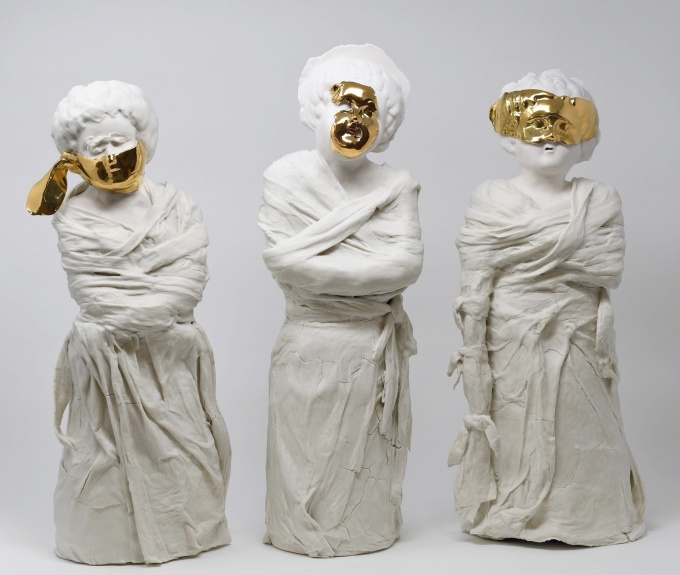Campus news
Photography students document community memories for exhibition

Artist Kimberly Chapman's work confronts what women have been made to endure, turning here to the legacy of nineteenth-century asylums. Pictured here, Gold Masked Women (2020). Porcelain, glaze, gold luster. Photo courtesy of the artist.
By VICKY SANTOS
Published November 19, 2025
When Cassandra Cook, an instructional support technician for photography in the Department of Art, received an email over the summer from Anna Wager, curator of UB Art Galleries, she didn’t expect it would spark such a meaningful project for her students. Wager and Ohio artist, Kimberly Chapman, were looking to include a community component into Chapman’s new exhibit. Cook saw an opportunity to involve a small group of dedicated students, and together, they came up with the “Buffalo Remembrance Project: Community Documentation Day.”
“I selected five students who are really focused in photography,” says Cook. “This is a perfect opportunity for them to gain hands-on, project-based experience.”
The special one-day event is dedicated to preserving the memory of women institutionalized at the Buffalo State Asylum for the Insane between 1880 and 1974.
“We're asking the public to bring a memento from a family member, in order to share more about their relative. These objects, however small, are powerful witnesses to individual lives that deserve to be seen and acknowledged,” says Anna Wager, curator of exhibitions at the UB Art Galleries.
The collection event will take place Friday, Nov. 21, 2025, from 12–6 p.m. at UB Anderson Gallery.
Community participants are encouraged to bring items connected to the women in their family and their time at the asylum. Items such as letters, photographs, clothing, combs, wallets or other mementos belonging to a woman who was once confined to the asylum.
Each student photographer will document both the individual and their object and participants will receive a professional 8 x 10 print of their photographed object in early 2026.
“This kind of opportunity doesn’t happen all the time,” says Cook. “It’s been inspiring to see the students grow—not just technically, but professionally—understanding what collaboration and real-world documentation look like.”
Lily Borer, a studio art student, agrees with Cook. "To have such an in depth and intimate opportunity to photograph it is something I will always be grateful for. Working with my fellow classmates and my professor has also been a fulfilling experience throughout the entire process so far."
Cook says the nature of the project encourages both creativity and accountability. “Some are shooting film, some digital; some black-and-white, some color,” she noted. “They’re learning to make decisions that communicate meaning, not just technique.”
Eric Ruettimann, who is working on his bachelor in fine arts with a photography concentration, says the students are creating a visual record that bridges memory, art and place.
“This project has really excited me from the beginning because in my own photographic practice, I’ve always had an interest in places that have been left untouched,” says Ruettimann” Documenting these places is a way that I see of giving them a new light after not being used or occupied for years, or decades.”
The students’ photographs will later become part of the exhibition at UB’s Anderson Gallery, with prints digitally printed and framed over winter break. Cook says the open-ended nature of the project encourages both creativity and accountability.
“Some are shooting film, some digital; some black-and-white, some color,” says Cook. “They’re learning to make decisions that communicate meaning, not just technique.”
The resulting images will be displayed in early 2026 in an exhibition at The Lipsey Architecture Center Buffalo (located at the Richardson Olmsted Campus, the former site of the asylum.) This special installation will run concurrently with Kimberly Chapman’s exhibition, “Eighty-Six Reasons for Asylum Admission.” Paired together, the two pieces form a powerful visual dialogue between personal memory and institutional history.
“It takes a special person to want a community component to their art and wanting to make sure there’s student engagement. I think that's really important,” Cook says of Chapman.
Chapman uses her art to shed light on dark topics, and her current exhibit is a perfect example of this practice. It focuses on women who were committed to asylums – just like the historic Richardson Olmsted Campus which previously housed the Buffalo State Asylum. The exhibit is on display at the Martha Jackson Gallery until Feb. 28,
“My hopes are that working with this artist will not only open new opportunities for myself in the future, but also bring a spotlight on Buffalo’s architectural history, and more specifically the history of the Richardson Olmsted campus’s rich history,” says Ruettimann.